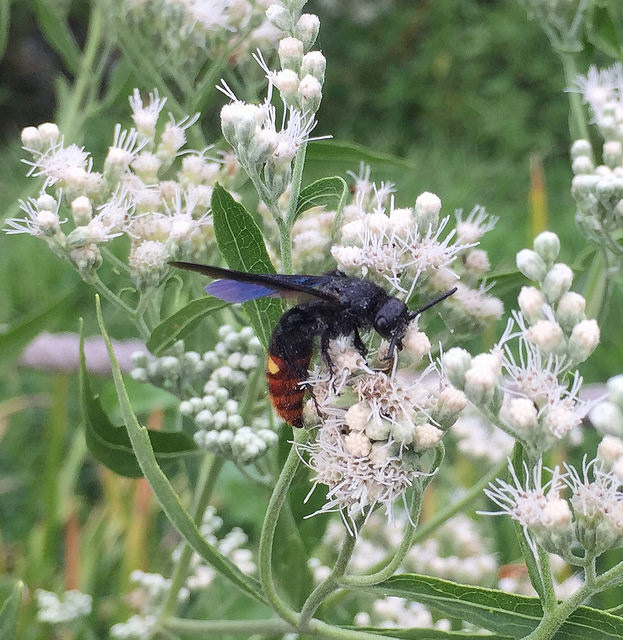Map Snapshot

























496 Records
Seasonality Snapshot
Source: Wikipedia
| Scolia dubia | |
|---|---|

| |
| Scolia dubia in Maryland on goldenrod | |
| Scientific classification | |
| Domain: | Eukaryota |
| Kingdom: | Animalia |
| Phylum: | Arthropoda |
| Class: | Insecta |
| Order: | Hymenoptera |
| Family: | Scoliidae |
| Genus: | Scolia |
| Species: | S. dubia
|
| Binomial name | |
| Scolia dubia Say, 1837
| |
Scolia dubia, also known as the two-spotted scoliid wasp[1] or a blue-winged scoliid wasp, is a species in the family Scoliidae.
Description and identification
[edit]S. dubia is a 2.0–2.5-centimeter (0.8–1.0 in) long wasp.[1] The body is black from the head through the first or second segment of the abdomen. The second third abdominal segment and beyond are red. The nominate subspecies possesses has the second abdominal segment black and two yellow spots on the third tergite, which are lacking in the subspecies S. dubia haematodes. The wings are violaceous or with blueish reflections.[2][1]
Males are colored as the female of their respective subspecies but have longer antennae and seven rather than six metasomal segments.[1][3]
The subspecies S. dubia haematodes is colored much like Triscolia ardens but can be recognized by the forewing only possessing two submarginal cells rather than three in T. ardens.[2]
Distribution
[edit]This species ranges from New England to Florida and west to California in the United States.[1][4] The southern extent of its range extends to Coahuila, Mexico.[2]
Biology
[edit]Females burrow into ground in search of grubs, particularly those of the green June beetle, Cotinis nitida, and some research suggests, possibly the Japanese beetle, Popillia japonica.[3] The wasp stings the grub and frequently burrows farther down to construct a cell and lay an egg on the host. The larva pupates and overwinters inside the body of the host.[1]
Adults collect nectar from flowers from July to September or October.[1]
Males of this species have been observed taking part in large mating flights from mid-August to early September in Virginia.[3]
Subspecies
[edit]There are two subspecies of S. dubia:[5]
- Scolia dubia dubia Say, 1837
- Scolia dubia haematoes Burmeister, 1854
Gallery
[edit]-
Scolia dubia dubia photographed in New York.
-
Scolia dubia haematodes photographed in Texas.
-
Scolia dubia dubia in Virginia
References
[edit]- ^ a b c d e f g Holm, Heather (2021). "Chapter 10 Scoliidae: Scoliid Wasps". Wasps: Their Biology, Diversity, and Role as Beneficial Insects and Pollinators of Native Plants. Minnetonka, MN: Pollination Press LLC. pp. 214–229. ISBN 9780991356317.
- ^ a b c Ramírez-Guillén, Luis Damián; Falcon-Brindis, Armando; Gómez, Benigno (2022). "The Scoliidae wasps (Hymenoptera: Scolioidea) of Mexico: taxonomy and biogeography". Zootaxa. 5214 (1): 47–88. doi:10.11646/zootaxa.5214.1.2.
- ^ a b c Alcock, John (2016). "The Scramble Competition Mating System of Scolia dubia (Hymenoptera: Scoliidae)". Journal of the Kansas Entomological Society. 89 (2): 168–173. Retrieved 29 August 2022.
- ^ MacKay, William P. (1987). "The Scoliid Wasps of the Southwestern United States (Hymenoptera: Scoliidae)". The Southwestern Naturalist. 32 (3): 357–362. Retrieved 2023-07-17.
- ^ Osten, T. (2005). "Checkliste der Dolchwespen der Welt (Insecta: Hymenoptera, Scoliidae). Teil 1: Proscoliinae und Scoliinae: Campsomerini. Teil 2: Scoliinae: Scoliini. Teil 3: Literatur" [Checklist of the Scoliidae of the World. Part 1: Proscoliinae and Scoliinae: Campsomerini. Part 2: Scoliinae: Scoliini. Part 3: Literature] (PDF). Bericht der Naturforschenden Gesellschaft Augsburg (in German). 62 (220–221): 1–62. Retrieved 2023-07-17.
External links
[edit]- Blue-winged wasp eating nectar in flowers by GoTrails (2019)





























